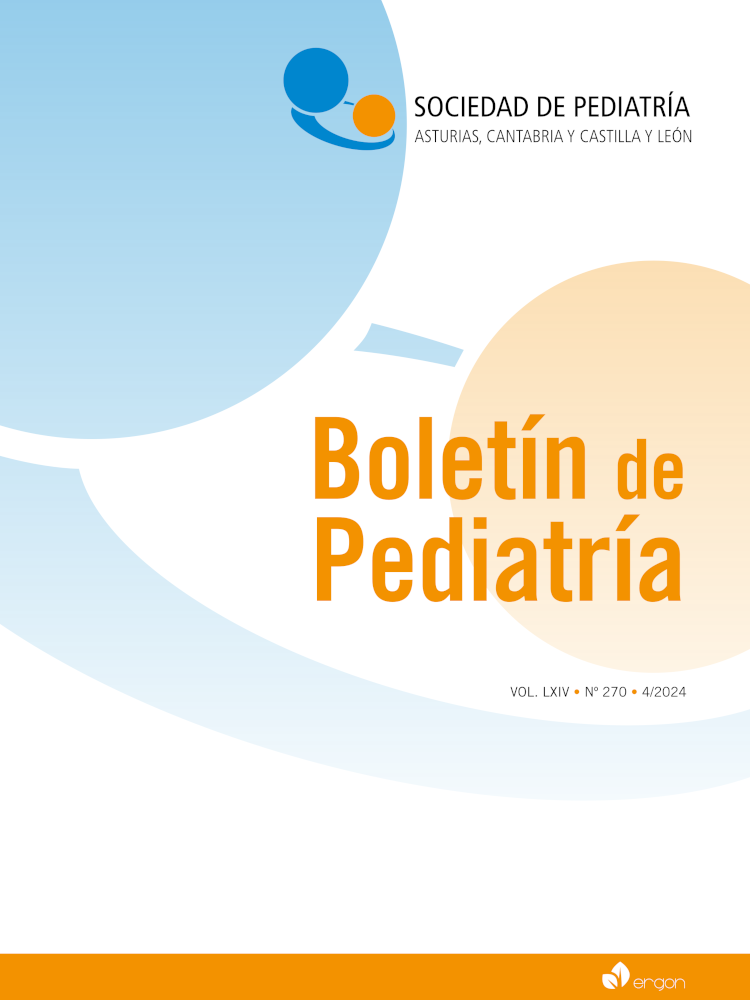Abstract
Introduction. Obstetric brachial palsy (OBP) is a relatively common pathology caused by traction of the brachial plexus during childbirth. Although the prognosis is generally good, in many cases multidisciplinary therapy is required and patients may not fully recover function.
Objective. To determine the incidence of OBP among newborns in our hospital with a descriptive analysis of the sample of newborns suffering from this complication. To analyze the requirement for rehabilitative and/or surgical treatment and the functional prognosis.
Patients and methods. Observational, longitudinal and retrospective study of newborns controlled by the Rehabilitation Service of our hospital for OBP between 2015 and 2022.
Results. Between 2015 and 2022, 18 cases have been documented. The incidence among those born in our hospital has been 1.1/1,000 live births. 61% were from instrumental births and 16.7% from eutocic births. 33% were shoulder dystocias and 27.8% had a coexisting fracture of the ipsilateral clavicle. 38.8% were macrosomic (weight > 4,000 g) and 66.6% had weight > p90. 72.2% had upper paralysis and 22% complete, with exclusive lower paralysis found in one patient. Regarding the evolution, 33% were referred to Plastic Surgery, all requiring surgical intervention. 61% had a good evolution with complete recovery (81.8% of those born in our hospital).
Conclusions. Although PBO usually has a good prognosis with adequate rehabilitation follow-up, those neonates with complete paralysis usually show sequelae despite surgical treatment. A multidisciplinary approach with good coordination between professionals is necessary.
References
Bahm J, Ocampo-Pavez C, Disselhorst-Klug C, Sellhaus B, Weis J. Obstetric brachial plexus palsy. Dtsch Arztebl Int. 2009; 106(6): 83-90. https://doi.org/10.3238/arztebl.2009.0083
Malessy MJA, Pondaag W, Yang LJS, Hofstede-Buitenhuis SM, Le Cessie S, Van Dijk JG. Severe obstetric brachial plexus pal- sies can be identified at one month of age. PLoS One. 2011; 6(10): e26193. https://doi.org/10.1371/journal.pone.0026193
Shah V, Coroneos CJ, Ng E. The evaluation and management of neonatal brachial plexus palsy. Paediatr Child Health. 2021; 26(8): 493-7. https://doi.org/10.1093/pch/pxab083
Vaquero G, Ramos A, Martínez JC, Valero P, Núñez-Enamorado N, Simón-De las Heras R, et al. Parálisis braquial obstétrica: incidencia, seguimiento evolutivo y factores pronósticos. Rev Neurol. 2017; 65(01): 19-25. https://doi.org/10.33588/rn.6501.2016504
Heise CO, Martins R, Siqueira M. Neonatal brachial plexus palsy: a permanent challenge. Arq Neuropsiquiatr. 2015; 73(9): 803-8. https://doi.org/10.1590/0004-282X20150105
Jiménez Parrilla P. Parálisis braquial [Internet]. Protocolos de la Sociedad Española de Neonatología. 2023; 254-8. [citado 4 marzo 2024]. Disponible en: https://www.seneo.es/index.php/ publicaciones/protocolos-de-la-seneo-2023
Rodríguez-Alarcón Gómez J, Marcos JCM, Mar L. La patología neonatal asociada al proceso del parto [Internet]. Protocolos Diagnóstico Terapéuticos de la AEP: Neonatología. 2008; 126-33 [citado 4 marzo 2024]. Disponible en: https://www.researchgate.net/publication/292767125_La_patologia_neonatal_asociada_al_proceso_de_parto
Ruchelsman DE, Pettrone S, Price AE, Grossman JAI. Brachial plexus birth palsy: an overview of early treatment considerations. Bull NYU Hosp Jt Dis. 2009; 67(1): 83-9.
Govindan M, Burrows HL. Neonatal brachial plexus injury. Pedia- tr Rev. 2019; 40(9): 494-96. https://doi.org/10.1542/pir.2018-0113
Lin JS, Samora JB. Brachial plexus birth injuries. Orthop Clin North Am. 2022; 53(2): 167-77. https://doi.org/10.1016/j.ocl.2021.11.003
De Francesco CJ, Shah DK, Rogers BH, Shah AS. The epidemiology of brachial plexus birth palsy in the United States: Declining incidence and evolving risk factors. J Pediatr Orthop. 2019; 39(2): e134-40. https://doi.org/10.1097/BPO.0000000000001089
Caron E, Gienapp AJ, Files H, Ridley-Pryor T. Brachial plexus birth injury: A single-center study. Clin Pediatr (Phila). 2023; 62(12): 1489-96. https://doi.org/10.1177/00099228231163698
Elmas B, Ercan N, Ersak DT, Ozdemir EU, Çelik IH, Tapisiz OL, et al. Risk factors for brachial plexus injury and permanent sequelae due to shoulder dystocia. Niger J Clin Pract. 2022; 25(12): 2016-23. https://doi.org/10.4103/njcp.njcp_464_22
Manske MC, Miller PE, Bauer AS. Prevalence of perinatal factors in infants with brachial plexus birth injuries and their associa- tion with injury severity. J Perinatol. 2023; 43(5): 578-83. https://doi.org/10.1038/s41372-022-01594-0
López Almejo L, Romero Rocha JA, Urzúa Portillo LC, Pérez Lima FY, Espinosa De Los Monteros Kelley AF, Barraza Arrambide RH, et al. Historia natural de la lesión de plexo braquial de nacimiento. Ortho-Tips. 2020; 16(4): 162-72. https://doi.org/10.35366/97815
Buterbaugh KL, Shah AS. The natural history and management of brachial plexus birth palsy. Curr Rev Musculoskelet Med. 2016; 9(4): 418-26. https://doi.org/10.1007/s12178-016-9374-3
Abzug JM, Mehlman CT, Ying J. Assessment of current epide- miology and risk factors surrounding brachial plexus birth palsy. J Hand Surg Am. 2019; 44(6): 515.e1-e10. https://doi.org/10.1016/j.jhsa.2018.07.020
Labrandero De Lera C, Pascual Pascual SI, Pérez Rodríguez J, Roche Herrero MC. Parálisis braquial obstétrica: epidemiología y secuelas. Estudio retrospectivo de nuestra casuística. Rev Neurol. 2008; 46(12): 719-23. https://doi.org/10.33588/rn.4612.2007623
González-Bosquet E, Hernández L, Borrás M, Lailla JM. Revisión de las parálisis braquiales neonatales observadas en el Hospital Sant Joan de Déu de Barcelona. Prog Obstet Ginecol. 2005; 48(1): 4-7. https://doi.org/10.1016/S0304-5013(05)72348-7
Sjoberg I, Erichs K, Bjerre I. Cause and effect of obstetric (neonatal) brachial plexus palsy. Acta Paediatr Scand. 1988; 77(3): 357-64. https://doi.org/10.1111/j.1651-2227.1988.tb10660.x
Osorio M, Lewis S, W. TSe RW. Promoting recovery following birth brachial plexus palsy. Pediatr Clin North Am. 2023; 70(3): 517-29. https://doi.org/10.1016/j.pcl.2023.01.016
Vergara Amador EM. Parálisis obstétrica del plexo braquial. Revisión del estado actual de la enfermedad. Rev Fac Med. 2014; 62(2): 255-63. https://doi.org/10.15446/revfacmed.v62n2.45416

This work is licensed under a Creative Commons Attribution-NonCommercial 4.0 International License.
Copyright (c) 2024 Boletín de Pediatría
